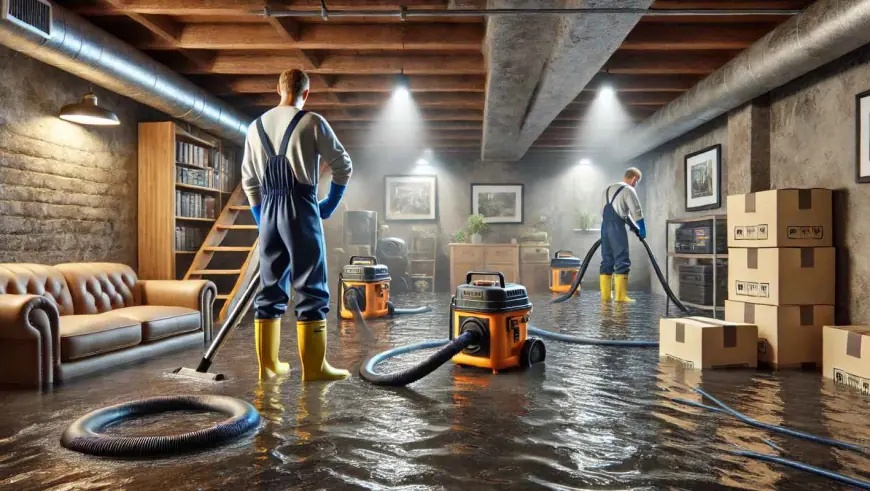Dealing with Water Damage in Your Bathroom? Here's How to Restore It
Water damage in the bathroom is a common problem that many homeowners encounter.

Water damage in the bathroom is a common problem that many homeowners encounter. Whether caused by leaking pipes, poor ventilation, or failing seals, excess moisture can lead to serious structural damage and health concerns. If not addressed promptly, water damage can contribute to mold growth, weaken flooring, and even affect the stability of walls. Acting quickly can help prevent costly repairs and potential health risks.
Signs of Water Damage in the Bathroom
Spotting water damage early can save you from extensive repairs. Be on the lookout for the following signs:
-
Peeling Paint or Wallpaper – Excessive moisture can cause paint or wallpaper to bubble, peel, or warp.
-
Soft or Warped Flooring – Water can seep under tiles or wooden floors, making them soft or misshapen.
-
Mold and Mildew Growth – Persistent dampness fosters mold and mildew, often appearing as black or green patches.
-
Musty Odor – A damp, stale smell may indicate hidden moisture buildup.
-
Water Stains or Discoloration – Yellow or brown stains on walls and ceilings suggest water penetration.
If you notice any water damage bathroom problems, taking immediate action is essential to prevent further deterioration.
Common Causes of Bathroom Water Damage
Understanding what leads to water damage can help you take preventive measures. Some of the most frequent causes include:
-
Leaky Pipes – Old or damaged pipes may develop leaks, leading to continuous moisture accumulation.
-
Inadequate Ventilation – Without proper airflow, steam from showers and baths increases humidity, promoting mold growth.
-
Cracked Tiles and Grout – Gaps in tiling allow water to seep into walls and floors.
-
Overflowing Toilets and Sinks – Plumbing blockages or malfunctions can cause water to spill onto floors, affecting surrounding areas.
-
Worn Seals Around Fixtures – Aging or deteriorated caulking around bathtubs, sinks, and toilets can allow water intrusion.
How to Restore a Water-Damaged Bathroom
If your bathroom has sustained water damage, follow these steps to restore it effectively:
1. Identify and Stop the Water Source
Before beginning any restoration, locate the source of the water issue. Shut off the water supply if there is a leak and consult a plumber if necessary. For ventilation issues, install an exhaust fan or ensure windows remain open to reduce humidity.
2. Remove Affected Materials
Assess the extent of the damage and remove compromised materials. This may include peeling paint, water-damaged drywall, or flooring. When dealing with mold, wear protective gear such as gloves and a mask.
3. Dry the Area Thoroughly
Speed up the drying process by using fans, dehumidifiers, or natural airflow. Eliminating moisture quickly helps prevent further mold growth. In severe cases, specialized drying equipment may be needed.
4. Clean and Disinfect
Mold and bacteria can thrive in damp areas, so thoroughly disinfect all surfaces. A solution of water and white vinegar or a commercial mold remover can help eliminate spores. Pay special attention to grout, tiles, and walls.
5. Repair and Replace Damaged Fixtures
Once everything is dry, the repairs begin. Replace compromised flooring, reapply caulk to fixtures, and repaint walls using mold-resistant paint. If drywall or wooden structures are severely damaged, replacing them may be necessary.
6. Enhance Ventilation
Improving airflow is crucial in preventing future water damage. Use an exhaust fan, a dehumidifier, or keep windows open after showering to reduce moisture buildup. Regular maintenance of grout, seals, and plumbing also helps minimize risks.
Preventing Future Water Damage in Your Bathroom
Taking preventive steps can save you from costly repairs and keep your bathroom in top condition. Consider the following strategies:
-
Inspect Plumbing Regularly – Check for leaks around pipes, under sinks, and near toilets.
-
Seal Cracks and Gaps – Reapply caulk around bathtubs, sinks, and tiles as needed.
-
Control Humidity Levels – Use proper ventilation methods to keep humidity low.
-
Maintain Drains – Prevent blockages by regularly cleaning shower and sink drains.
-
Choose Waterproof Materials – opt for moisture-resistant paint, grout, and flooring to reduce water absorption.
By implementing these precautions, you can significantly reduce the chances of bathroom water damage and maintain a safe, healthy living space. Addressing water issues as soon as they arise not only protects your home but also ensures a cleaner, mold-free environment for your family.
What's Your Reaction?
 Like
0
Like
0
 Dislike
0
Dislike
0
 Love
0
Love
0
 Funny
0
Funny
0
 Angry
0
Angry
0
 Sad
0
Sad
0
 Wow
0
Wow
0





















































